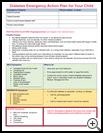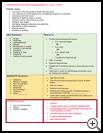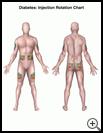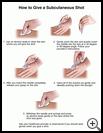
Diabetes: Giving Insulin with a Needle and Syringe or a Pen
________________________________________________________________________
KEY POINTS
- Insulin is injected into the fat layer just beneath the skin by using a needle and syringe or by using a special pen. The best places to give insulin are the belly, upper arms, thighs, and buttocks. You should change the place where you give your child insulin with each injection (shot).
- It is important to learn the right way to give insulin. Your child’s healthcare provider or certified diabetes educator will show you how to use a needle and syringe or pen, and how to store, mix, and inject insulin.
- It is best not to reuse insulin needles. Needles that are reused may get dull from going through the rubber stopper on the insulin bottle over and over. A dull needle may cause pain and more damage to your child’s skin and tissues. There is also a risk of infection if you reuse needles and syringes, or you can contaminate the insulin.
- Never share used needles, syringes, or pens with another person.
________________________________________________________________________
What are needles and syringes and pens?
Needles and syringes, and special pens, are 2 types of devices used to inject insulin into the fat layer just under the skin.
Your child’s healthcare provider or certified diabetes educator will show you how to use a needle and syringe or pen, and how to store, mix, and inject insulin.
To give your child insulin by injection (shot), you will need to learn:
- What kind or kinds of insulin your child will be using
- What dosage of insulin your child needs
- When you should give your child insulin
- Where and how to inject the insulin
- How to store the insulin
Needle and syringe
If using a needle and syringe, you also need to learn:
- What kind of needle and syringe to use
- How to mix different types of insulin if needed
- How to use a needle and syringe
- What to do with used needles and syringes
Syringes come with different needle widths and lengths. Insulin syringes have thin, short needles that are easy to insert into the skin.
The amount of insulin a syringe can hold varies. Insulin is measured in units. Syringes have markings on the side that measure the units.
Using needles and syringes is one of the least expensive ways to give insulin by injection. It works best when:
- You can see clearly enough to read the label on the insulin bottle (vial) and fill a syringe with the correct dose.
- Your hands are steady enough to puncture the rubber seal at the top of the insulin bottle and then inject the insulin into the skin.
- You have access to all the supplies and insulin you need at any time of the day or night.
Your child’s healthcare provider will help you choose which needle and syringe size will work best for your child. Do not change the syringe or needle size without checking with your child’s provider.
Pens
If using a pen, the insulin is not drawn from one container into another. The pen has a little plunger inside. When you set the dose on the pen, you are setting how far forward this plunger will move. This sets the amount of insulin that is given with each dose. Insulin is given by pushing a button on the pen.
Pens can be easier to use if you have vision problems or find it too difficult to fill or use a needle and syringe and an insulin bottle. Reusable pens may have safety features such as a memory that shows how many units were given with last dose and how many hours have passed since the last injection.
Connected insulin pens (CIPs) electronically record and send information about the last insulin dose and the time it was given. Healthcare providers may use this information to change your treatment.
An insulin pump can also be used to inject insulin. Ask the pharmacist or healthcare provider if you have questions about needles, syringes, pens, insulin pumps, insulin, or dosage.
Where should I inject the insulin?
Insulin is injected into the fat layer just beneath the skin. The best places to give insulin are the belly, upper arms, thighs, and buttocks. There are different places within each of these areas where you can give the injection. You should change the places where you give the insulin each time. Injecting into the same site repeatedly can cause hard lumpy areas and the insulin may not be absorbed well.
For example, there might be 6 different places on the thigh that you can use. Injection sites should be at least one inch apart. This will give you more than 50 different places to give an injection before having to use the same place again. This is called rotating the sites.
Healthy tissue absorbs insulin properly. Rotating injection sites helps prevent skin problems such as fatty lumps forming under the skin. These fatty lumps don’t absorb the insulin in the same way as healthy tissue absorbs the insulin.
Use a chart to keep track of the sites used.
- Do not give insulin into an area that is swollen, hard, or where there is a rash or sore.
- Do not give insulin in areas that have been used for injections that look raised.
- Do not give insulin just before a bath or shower or using a hot tub. The warm water will draw more blood to the skin, causing the insulin to be absorbed more quickly. This can cause a serious low blood glucose (sugar) reaction.
- Insulin is absorbed more quickly from the belly than from the arm and more quickly from the arm than from the thigh or buttock. This usually does not cause problems. If your child has low blood glucose levels when you use some sites, you may want to use the belly or arm in the morning, and the thigh or buttock in the evening.
- If insulin is injected into an arm or leg that your child will be using a lot during physical activity, your child’s body may absorb the insulin too fast. For example, if your child is going to run, don't inject insulin into the leg. If your child is going to play tennis, avoid injecting into the tennis arm.
How do I inject the insulin?
It is important to learn the right way to give insulin with a needle and syringe or with a pen. A healthcare provider or certified diabetes educator will show you how to inject insulin.
- Always wash your hands with soap and water before you give an insulin shot.
- Keep the insulin injections 1 inch away from a scar or the belly button. Do not give insulin into a place that is bruised, swollen, or tender.
- If you don’t give the insulin deeply enough, it can cause a lump, pain, or red spot. If you give the injection too deep into the muscle, it may be more painful and cause the insulin to be absorbed too quickly. This doesn’t happen often if you are using the right size needle.
- To inject:
- Pinch the skin gently
- Insert the needle at 90 degrees, which means straight down.
- Push the plunger on the syringe or the button on the pen.
- Leave the needle and syringe in place for 5 seconds, or with a pen, leave the needle in place for 10 seconds.
- Withdraw the needle straight out at the same angle used when inserting it.
- Press gently on the injection site for 5 to 10 seconds.
- Avoid injecting insulin into a large vein or artery. This is very unlikely if you are using the recommended sites. If you do inject insulin into a large vein or artery, the effect of the insulin will last just minutes instead of hours.
- Don’t worry about accidentally injecting a small bubble of air. It is not harmful.
How do I store the insulin?
It is best to store unopened insulin bottles and pens in the refrigerator. Warm insulin to room temperature before you use it. You can warm it up by rolling a filled syringe between your hands for a minute or 2. If you warm the insulin to room temperature, it’s less likely to sting or cause red spots on the skin. Insulin pens that you are using must be stored at room temperature. Rolling the syringe or pen also mixes the insulin. Don’t shake an insulin bottle to mix it because this can create bubbles in the insulin.
You can store an opened bottle of insulin at room temperature for up to 14 to 42 days, depending on the type of insulin. Insulin will spoil if it gets above 85°F (29°C) or if it freezes. Insulin bottles and pens should not be left in a car in the summer or winter. Ask a pharmacist how your insulin should be stored.
Watch your child's blood glucose levels carefully when the insulin bottle is almost empty. If the blood glucose starts to be unusually high, the last bit of insulin should be thrown out. Also throw insulin away if:
- Clumps of intermediate-acting insulin are sticking to the side of the bottle
- Clear, rapid-acting insulin looks cloudy
- The insulin is past the expiration date
- An open bottle has been stored at room temperature or in the refrigerator for more than 14 to 42 days, depending on the type of insulin
- An open pen device has been stored at room temperature for over 14 to 42 days, depending on the type of insulin
Can I reuse needles and syringes?
Plastic syringes are recommended for one-time use only. If for some reason you need to reuse a syringe after using it, push the plunger up and down to get rid of any insulin left in the needle. Wipe the needle off with an alcohol swab. Put the cap over the needle and store the syringe and needle in the refrigerator until the next time you need to use it.
It is best not to reuse insulin needles. Needles that are reused may get dull from going through the rubber stopper on the insulin bottle over and over. A dull needle may cause pain and more damage to your child’s skin and tissues. There is also a risk of infection if you reuse needles and syringes, or you can contaminate the insulin.
If you are having problems getting the supplies you need or cannot afford supplies, talk to your healthcare provider, certified diabetes educator, or pharmacist. There may be programs that can help you.
Never share used needles, syringes, or pens with another person. Dispose of used needles in a hard, plastic bottle with a screw cap or metal box with a tight lid. Ask your waste disposal company or county health department how to get rid of the used needles.
Keep a list of all the medicines your child takes, including the type and dose of insulin your child uses.
Make sure you carry glucose to take if blood glucose levels get too low. Glucose tablets or gel are good for emergencies.
Have your child carry a medical ID such as a card or bracelet that says your child has diabetes.
Last modified: 2022-02-23
Last reviewed: 2022-02-05




